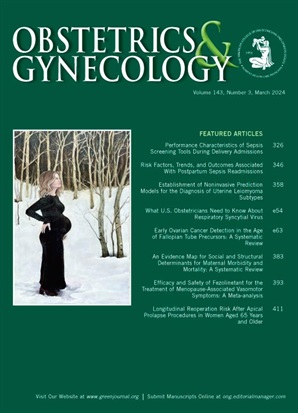Stakeholder Perspectives of New Tailored Prenatal Care Delivery.
IF 4.7
2区 医学
Q1 OBSTETRICS & GYNECOLOGY
引用次数: 0
Abstract
OBJECTIVE To evaluate obstetric stakeholders' attitudes and implementation considerations regarding the adoption of key components of a newly tailored prenatal care recommendation-PATH (Plan for Appropriate Tailored Healthcare in Pregnancy). METHODS We conducted a national listening tour that used qualitative focus groups from March 2022 to June 2023. We recruited a national sample of obstetric care clinicians, patients, advocates, policymakers, and payers using maximum variation sampling. We explored core PATH domains, including 1) addressing social needs, 2) telemedicine and remote monitoring, and 3) targeted visit schedules. Participants were queried about their perceived barriers to adopting new recommendations and needed supports. We performed a qualitative content analysis to identify positive attitudes, concerns, and multilevel implementation considerations for each recommendation. RESULTS In total, 102 obstetric stakeholders participated in nine focus groups from 10 obstetric care organizations, seven patient advocacy and equity organizations, nine policy and public health organizations, and four payer groups. Participants broadly supported the idea of care tailoring and raised important concerns about unintended inequities and negative health outcomes that could arise with inappropriate application of the model. Participants affirmed that addressing social needs is crucial to improving prenatal care access and pregnancy outcomes but identified barriers including insufficient resources and support for interprofessional collaboration. Telemedicine and remote monitoring were widely accepted to improve care access and efficiency, but participants worried that limited access to digital infrastructure could exacerbate existing health disparities. Although participants recognized that targeted visit schedules could enhance visit attendance, care flexibility, and resource equity, some worried about the potential for missed services and worse health outcomes. Across all recommendations, participants identified patient-, clinic-, and policy-level considerations to improve the implementation of new prenatal care models. CONCLUSION PATH is an acceptable and feasible care model with the potential to improve the quality, equity, and efficacy of prenatal care. Multilevel implementation considerations must be integrated with routine use of PATH to promote sustainability across patient populations and settings.新的量身定制的产前护理交付利益相关者的观点。
目的评估产科利益相关者对采用新定制产前护理建议- path(妊娠期适当定制保健计划)关键部分的态度和实施考虑。方法:我们于2022年3月至2023年6月进行了一次全国倾听之旅,采用定性焦点小组。我们采用最大变异抽样方法,在全国范围内招募了产科护理临床医生、患者、倡导者、政策制定者和付款人。我们探索了PATH的核心领域,包括1)解决社会需求,2)远程医疗和远程监测,以及3)有针对性的就诊计划。参与者被问及他们认为采用新建议的障碍和需要的支持。我们进行了定性内容分析,以确定每个建议的积极态度、关注点和多层次实施考虑。结果共有102名产科利益攸关方参加了来自10个产科护理组织、7个患者倡导和公平组织、9个政策和公共卫生组织以及4个支付方团体的9个焦点小组。与会者广泛支持量身定制护理的想法,并对不适当应用该模式可能产生的意外不平等和负面健康结果表示严重关切。与会者肯定,解决社会需求对于改善产前护理的可及性和妊娠结局至关重要,但也指出了包括资源不足和专业间合作支持不足在内的障碍。远程医疗和远程监测已被广泛接受,以改善护理机会和效率,但与会者担心,利用数字基础设施的机会有限可能会加剧现有的保健差距。虽然与会者认识到,有针对性的就诊时间表可以提高出勤率、护理灵活性和资源公平,但一些人担心可能会错过服务和更糟糕的健康结果。在所有建议中,参与者确定了患者、诊所和政策层面的考虑因素,以改进新的产前护理模式的实施。结论path是一种可接受、可行的护理模式,具有提高产前护理质量、公平性和有效性的潜力。多层次实施考虑必须与适宜卫生技术方案的常规使用相结合,以促进患者群体和环境的可持续性。
本文章由计算机程序翻译,如有差异,请以英文原文为准。
求助全文
约1分钟内获得全文
求助全文
来源期刊

Obstetrics and gynecology
医学-妇产科学
CiteScore
11.10
自引率
4.20%
发文量
867
审稿时长
1 months
期刊介绍:
"Obstetrics & Gynecology," affectionately known as "The Green Journal," is the official publication of the American College of Obstetricians and Gynecologists (ACOG). Since its inception in 1953, the journal has been dedicated to advancing the clinical practice of obstetrics and gynecology, as well as related fields. The journal's mission is to promote excellence in these areas by publishing a diverse range of articles that cover translational and clinical topics.
"Obstetrics & Gynecology" provides a platform for the dissemination of evidence-based research, clinical guidelines, and expert opinions that are essential for the continuous improvement of women's health care. The journal's content is designed to inform and educate obstetricians, gynecologists, and other healthcare professionals, ensuring that they stay abreast of the latest developments and best practices in their field.
 求助内容:
求助内容: 应助结果提醒方式:
应助结果提醒方式:


